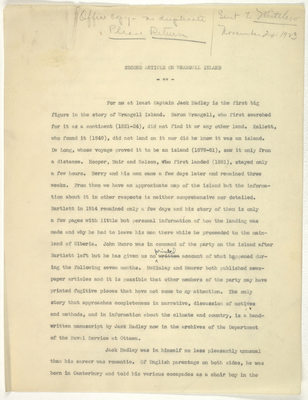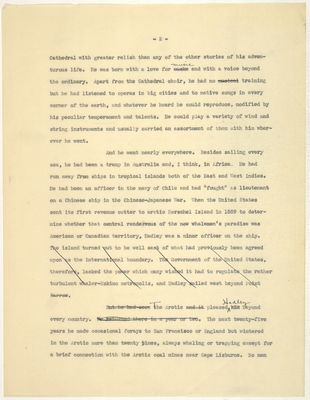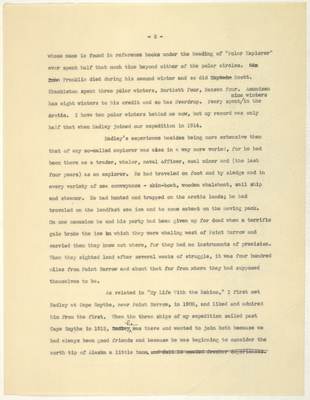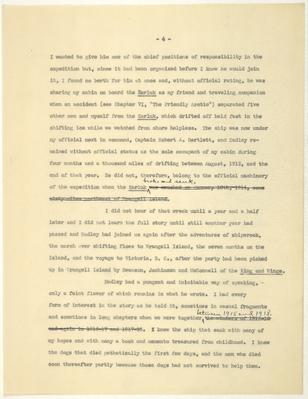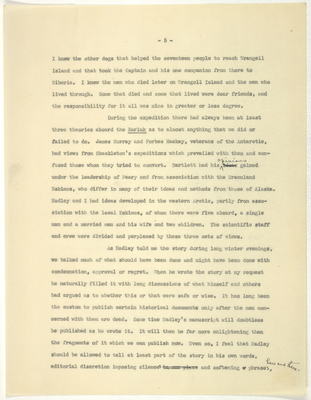Pages
stefansson-wrangel-09-25-004-001
Second Article on Wrangel Island
For me at least Captain Jack Haldey is the first big figure in the story of Wrangell Island. Baron Wrangell, who first searched for it as a continent (1821-24), did not find it or any other land. Kellet, who found it (1849), did not land on it nor did he know it was an island. De Long, whose voyage proved it to be an island (1879-81), saw it only from a distance. Hooper, Muir and Nelson, who first landed (1881), stayed only a few hours. Berry and his men came a few days later and remained three weeks. From them we have an approximate map of the island by the information about it in other respects is neither compregensive nor detailed. Bartlett in 1914 remained only a few days and his story of them is only a few pages with little but personal information of how the landing was made and why he had to leave his ment there while he proceeded to the mainland of Siberia. John Munro was in command of the party on the island after Bartlett left but he has given us no printed accound of what happened during the following seven months. McKinlay and Maurer both published newspaper artciled and it is possible that other members of the party may have printed fugitive pieces that have not come to my attention. The only story that approaches completeness is narrative, discussion of motives and methods, and in information about the climate and country, is a handwritten manuscripts by Jack Hadley now in the archives of the Department of the Naval Service at Ottawa.
Jack Hadley was in himself no less pleasantly unusual than his career was romantic. Of English parentage on both sides, he was born in Canterbury and told his various escapades as a choir boy in the
stefansson-wrangel-09-25-004-002
- 2 -
Cathedral with greater relish than any of the other stories of his adventurous life. He was born with a love for music and with a voice beyond the ordinary. Apart from the Cathedral choir, he had no musical training but he had listened to operas in big cities and to native songs in every corner of the earth, and whatever her heard he could reproduce, modified by his peculiar temperament and talents. He could play a variety of wind and string instruments and usually carried an assortmrnt of them with him wherever he went.
And he went nearly everywhere. Besides sailing every sea, he had been a tramp in Australia and, I think, in Africa. He had run away from ships in tropical islands both of the East and West Indies. He had been an officier in the navy of Chile and had "fought" as a lieutenant on a chinese ship in the Chinese-Japan War. When the United States sent its first revenue cutter to arctic Herschel Island in 1889 to determine whether that central rendevous of the new whalemen's paradise was American or Canadian territory, Hadley was a minor officer on the ship. The island turned out to be well east of what had perviously been agreed upon as the international boundary. The Government of the United States, therefore, lacked the power which many wished it has to regulate the rather turbulent whaler-Eskimo metropolis, and Hadley sailed west beyond Point Barrow.
But he had seen The Arctic and it pleased Hadley beyond every country. He returned there in a year or two. The nest twenty-five years he made occasional forays to San Francisco or England but wintered in the Arctic more than twenty times, always whaling or trapping except for a brief connection with the Arctic coal mines near Cape Lisburne. No man
stefansson-wrangel-09-25-004-003
- 3 -
whose name is found in reference books under the heading of "Polar Explorer" ever spent half that much time beyond either of the polar circles. Sir John Franklin died durind his second winter and so did Captain Scott. Shackleton spent three polar winters, Bartlett four, Nanson four. Amundsen has eight winters to his credit and so has Sverdrup. Peary spent nine winters in the Arctic. I have ten polar winters behind me now, but my record was only half that when Hadley joined our expedition in 1914.
Hadley's experiences besides being more extensive then that of any so-called explorer was also in a way more varied, for he had been there as a trader, whaler, naval officer, coal miner and (the last four years) as an explorer. He had traveled on foot and by sledge and in every variety of sea conveyance - skin-boat, wooden whaleboat, sail ship and steamer. He has hunted and trapped on the arctic lands; he has traveled on the landfast sea ice and to some extent on the moving pack. On one occation he and his party had been given up for dead when a terrific gale broke the ice on which they were whaling west of Point Barrow and carried them they knew not where, for they had no instruments of precision. When they sighted land after several weeks of struggle, it was four hundred miles from Point Barrow and about that far from where they had supposed themselves to be.
As related in "My Life With the Eskimo," I first met Hadley at Cape Smythe, near Point Barrow, in 1908, and liked and admired him from the first. When the three ships of my expedition sailed past Cape Smythe in 1913. Hadley he was there and wanted to join both because we had always been good friends and because he was beginning to consider the nort tip of Alaska a little tame and felt he needed fresher experiences.
stefansson-wrangel-09-25-004-004
- 4 -
I wanted to give him one of the cheif positions of responsibility in the expedition but, since it had been organised before I knew he would join it, I found no berth for him at once and, without official rating, he was sharing my cabin on board the Karluk as my friend and travelling companion when an accident (see Chapter VI, "The Friendly Arctic") separated five other men and myself from the Karluk, which drifted off held fast in the shifting ice while we watched from the shore helpless. The ship was now under my official next in command, Captain Robert A.Bartlett, and Hadley remained without official status as the sole occupant of my cabin during four months and a thousand miles of drifting between August, 1913, and the end of that year. He did not, therefore, belong to the official machinery of the expedition when the Karluk broke and sauk. was crushed on , some sixty miles northeast of Wrangell Island.
I did not hear of that wreck until a year and a half later and I did not learn the full story until still another year had passed and Hadley had jointed us again after the adventured of the shipwreck, the march over shifting floes to Wrangell Island, the seven months on the Island, and the voyage to Victoria, B.C., after the party had been picked up in Wrangell Island by Swenson, Jochimson and McConnell of the King and Winge.
Hadley had a pungent and inimitable way of speaking, only a faint flavour of which remians in what he wrote. I had every form of interest in the story as he told it, sometimes in casual fragments and sometimes in long chapters when we were together between 1915 and 1918. the winters of 1915-16 and again in 1916-17 and 1917-18. I knew the ship that sank with many of my hopes and with many a book and memento treasured from childhood. I knew the gods that died pathetically the first few days, and the men who died soon thereafter partly because those dogs had not survived to help them.
stefansson-wrangel-09-25-004-005
- 5 -
I knew the other dogs that helped the seventeen people to reach Wrangell Island and that took the Captain and his one occupanion from there to Siberia. I knew the men who died later on Wrangell Island and the men who lived through. Some that died and some that lived were dear friends, and the responsiblility for it all was mine in greater or less degree.
During the expedition there has always been at least three theories aboard the Karluk as to almost anything that we did or failed to do. James Murray and Forbes Mackay, veterans of the Antarctic, had view from Shackleton's expedition which prevailed with them and confused those whom they tried to convert. Bartlett had his opinions ideas gained under the leadership of Peary and from association with the Greenland Eskimos, who differ in many of their ideas and methods from those of Alaska, Hadley and I had ideas developed in the western Arctic, partly from association with the local Eskimos, of whom there were five aboard, a single man and a married man and his wife and two children. The scientific staff and crew were divided and perplexed by these three sets of views.
As Hadley told me the story during long winter evenings, we talked much of what should ahve been done and might have been done with condemnation, approval or regret. When he wrote the story at my request he naturally filled it with long discussions of what himself and others had argued as to whether this or that were safe or wise. It has long been the custom to publish certain historical documents only after the men concerned with them are dead. Some time Hadley's manuscript will doubtless be published as he wrote it. It will then be far more enlightening than the fragments of it which we can publish now. Even so, I feel that Hadley should be allowed to tell at least part of the story in his own words, editorial discretion imposing silences in one place and softening a phrases here and there
